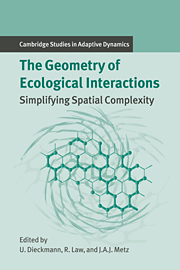Book contents
- Frontmatter
- Contents
- Contributing Authors
- 1 Introduction
- Part A Empirical and Statistical Background: A Plant Ecological Perspective
- Part B When the Mean-field Approximation Breaks Down
- Part C Simplifying Spatial Complexity: Examples
- Introduction to Part C
- 12 Spatial Scales and Low-dimensional Deterministic Dynamics
- 13 Lattice Models and Pair Approximation in Ecology
- 14 Moment Approximations of Individual-based Models
- 15 Evolutionary Dynamics in Spatial Host–Parasite Systems
- 16 Foci, Small and Large: A Specific Class of Biological Invasion
- 17 Wave Patterns in Spatial Games and the Evolution of Cooperation
- Part D Simplifying Spatial Complexity: Techniques
- References
- Index
- International Institute for Applied Systems Analysis
15 - Evolutionary Dynamics in Spatial Host–Parasite Systems
Published online by Cambridge University Press: 14 January 2010
- Frontmatter
- Contents
- Contributing Authors
- 1 Introduction
- Part A Empirical and Statistical Background: A Plant Ecological Perspective
- Part B When the Mean-field Approximation Breaks Down
- Part C Simplifying Spatial Complexity: Examples
- Introduction to Part C
- 12 Spatial Scales and Low-dimensional Deterministic Dynamics
- 13 Lattice Models and Pair Approximation in Ecology
- 14 Moment Approximations of Individual-based Models
- 15 Evolutionary Dynamics in Spatial Host–Parasite Systems
- 16 Foci, Small and Large: A Specific Class of Biological Invasion
- 17 Wave Patterns in Spatial Games and the Evolution of Cooperation
- Part D Simplifying Spatial Complexity: Techniques
- References
- Index
- International Institute for Applied Systems Analysis
Summary
Introduction
Simple mathematical models that describe the progression of a disease through a well-mixed population have been the subject of vast amounts of study in recent years (Anderson and May 1991). However, despite our fairly clear understanding of the dynamics produced by these simple epidemiological systems, many problems arise when the underlying assumption of spatial homogeneity no longer holds, as unfortunately is usually the case. Although many studies have realized the importance of space to disease spread (Cliff et al. 1981; Durrett 1988a; Dwyer 1992b; Bolker 1995; Bolker and Grenfell 1995; Cliff 1995; Durrett 1995a; Grenfell et al. 1995a; Metz and van den Bosch 1995; and Mollison and Levin 1995), generic phenomena are difficult to extract due to the vast amount of data produced by spatial simulations and the computationally expensive nature of the problem.
In this chapter I use a simple probabilistic cellular automaton (PCA) to investigate the effects of including discrete, spatially distributed populations, limited local interactions, and stochastic processes in the modeling framework. PCAs are the simplest form of stochastic, spatial models, yet they illustrate how many of our common mathematical techniques break down for this type of system. The PCA introduced here is a caricature model. I attempt to define the simplest form of a spatial disease model and neglect any detail or nongeneric behavior that would accompany the precise simulation of a disease. PCA models (or interacting particle systems) have been used with great success in a wide variety of ecological and epidemiological applications (Mollison 1977; Ermentrout and Edelstein-Keshet 1992; Durrett and Levin 1994a, 1994b; Rhodes and Anderson 1996).
- Type
- Chapter
- Information
- The Geometry of Ecological InteractionsSimplifying Spatial Complexity, pp. 271 - 291Publisher: Cambridge University PressPrint publication year: 2000
- 4
- Cited by



